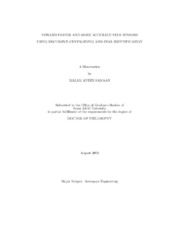| dc.description.abstract | The objective of this research is to study different novel developed techniques for spacecraft attitude determination methods using star tracker sensors. This dissertation addresses various issues on developing improved star
tracker software, presents new approaches for better performance of star trackers, and
considers applications to realize high precision attitude estimates.
Star-sensors are often included in a spacecraft attitude-system instrument suite, where
high accuracy pointing capability is required. Novel methods for image processing, camera
parameters ground calibration, autonomous star pattern recognition, and recursive star
identification are researched and implemented to achieve high accuracy and a high frame
rate star tracker that can be used for many space missions. This dissertation presents
the methods and algorithms implemented for the one Field of View 'FOV' StarNavI sensor
that was tested aboard the STS-107 mission in spring 2003 and the two fields of view
StarNavII sensor for the EO-3 spacecraft scheduled for launch in 2007. The results of
this research enable advances in spacecraft attitude determination based upon real time
star sensing and pattern recognition. Building upon recent developments in image
processing, pattern recognition algorithms, focal plane detectors, electro-optics, and
microprocessors, the star tracker concept utilized in this research has the following key
objectives for spacecraft of the future: lower cost, lower mass and smaller volume,
increased robustness to environment-induced aging and instrument response variations,
increased adaptability and autonomy via recursive self-calibration and health-monitoring
on-orbit. Many of these attributes are consequences of improved algorithms that are
derived in this dissertation. | en |


